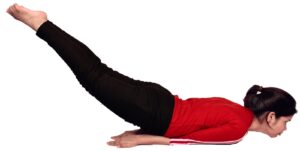Shalabhasana, the locust pose, is a prone lying yogasana with backward spine bending. The asana is an excellent yoga posture for improving the health and strength of the lower back. Initially, it is a little difficult to practice because it requires contraction of the lower back muscles, which are rarely utilised in daily activities. It is also known as the grasshopper pose because, in the final position, the legs are raised just like the tail of a grasshopper. It provides suitable impacts on the organs of lower body parts.

How to Do Shalabhasana: Technique & Instructions
Lie flat on the ground on a yoga mat, face downwards.
Your legs should be straight with the feet together; the soles should point upwards.
The arms can be placed either beside the body or under the body; the palms can face downwards, upwards or may be clenched.
Relax the whole body. Close your eyes.
Breathe out deeply. Then, inhale deeply.
Hold your breath and raise both legs, keeping them together and straight.
Hold the legs in the raised position while retaining your breath.
Try to stretch your chin in front of you as much as possible, but maintain contact with the ground.
Hold the final position for as long as you can without straining.
Then, slowly lower the legs and exhale.
This is one round. Do 3 to 4 games with awareness.
Breathing
Exhale profoundly and then inhale deeply while lying flat on the ground.
Retain the breath while raising the legs and holding the legs in the final position.
Exhale after slowly lowering the legs and breathing normally while relaxing the body.
Please keep in mind the breathing and movement throughout the practice.
While resting between rounds, remain aware of your breathing pattern and the relaxation of the whole body.
Contraindications/Safety
The locust pose shouldn’t be performed in the following conditions. Its limitations are:
Hernia
Hypertension
Heart ailments
Pregnancy
Peptic ulcers
Sciatica, Slipped disc and Back Injuries
Intestinal tuberculosis
Recently undergone abdominal surgery
Precautions
Try to keep the shoulders as close to the ground as possible.
Keep the chin in contact with the ground throughout the practice.
Keep your legs straight. There is a tendency to bend the legs when raised.
Ensure that your inhalation in the lying position immediately before doing the asana is as deep as possible. This ensures that you obtain the best possible abdomen, lungs and heart massage.
Try to allow the abdomen to sustain most of the body weight.
Benefits
Shalabhasana stimulates the whole autonomic nervous system, particularly the parasympathetic outflow.
In particular, it prepares the body to face emergencies or danger.
Shalabhasana stretches the nerves and improves blood circulation, allowing new oxygenated blood to circulate.
Shalabhasana profoundly massages the abdominal organs. The deep inhalation and retention of breath accentuate this massage.
It exerts pressure in the abdomen due to the body’s weight, which is transmitted to the lungs and heart via the diaphragm, improving the functioning of both these vital organs.
This asana has been found helpful in relieving sciatica and mild slipped discs, too.
Variation
Could you take the same starting position as given for shalabhasana?
Close your eyes and relax your whole body.
Then breathe in deeply, retain the breath and raise your left leg.

Use the back muscles as much as possible, assisted by the arms, to raise the left leg.
Keep your chin stretched forward on the ground and your shoulders as low as possible.
Keep your left leg raised in the final position while holding your breath.
Try to hold the final position for as long as possible without strain.
Then, lower the leg and breathe out slowly.
Allow your respiration rate to return to normal while resting on the ground.
Then, repeat the same procedure with the other leg.
